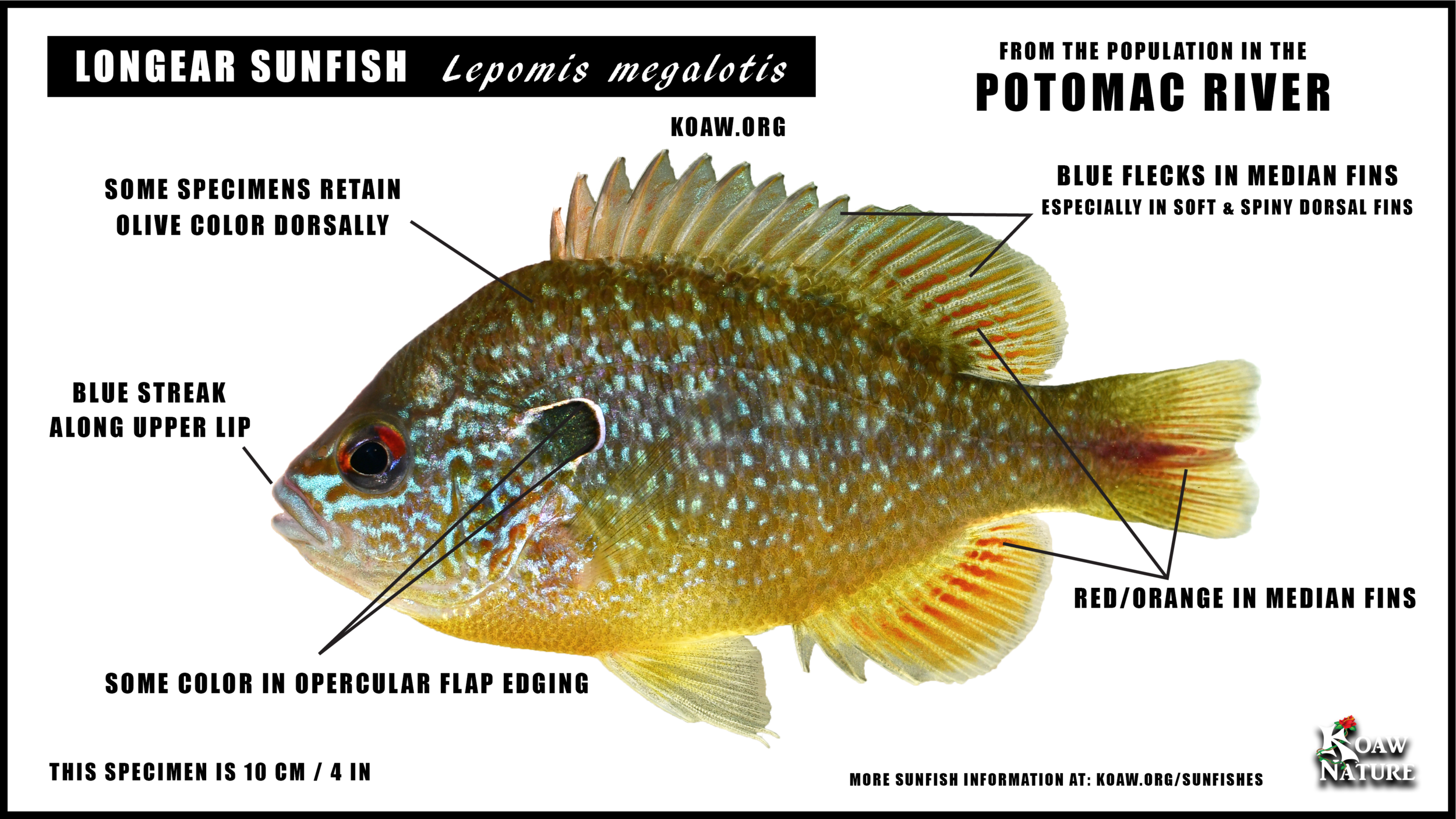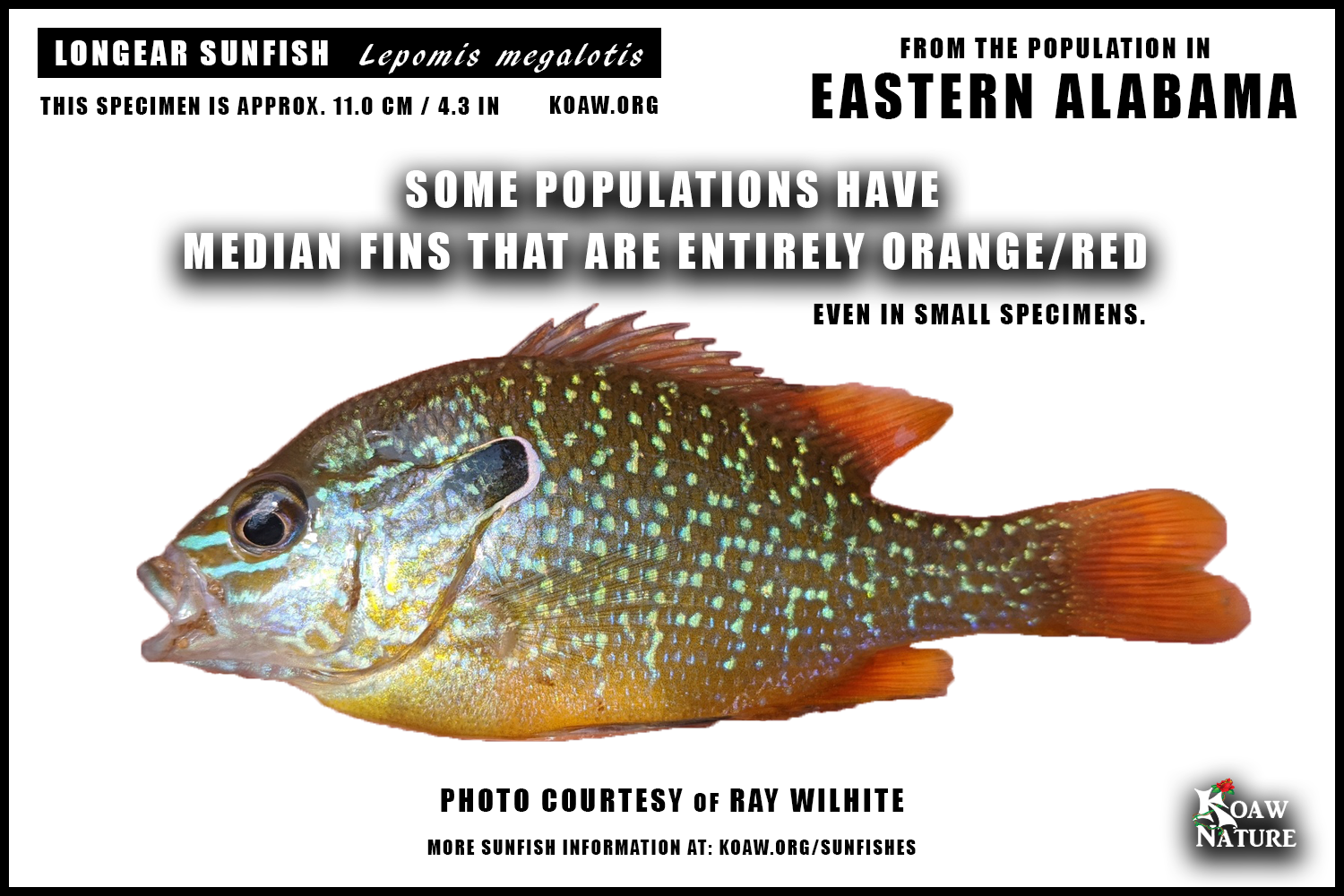By Koaw - November, 2020 (Updated 2022)
*Note that this species complex is most likely soon-to-be split, officially that is. A new study as of March, 2022 has put forth a strong argument to split the longear species complex into 6 lineages. See the video below or click here.
GENERAL: The longear sunfish (Lepomis megalotis - Rafinesque, 1820) is a species within Lepomis that often causes difficulty during identifications—seriously, don’t feel bad if you’re having a hard time identifying this species. The longear sunfish can be tough to ID, especially in regions where the dollar sunfish or northern sunfish are also present. (Side-by-side comparison images are below in the “SIMILAR SPECIES” section.)
Good features to assess to confirm an ID: 1) Blue spots on the body. 2) An ear flap (that likely will be elongated) with pale edging that may have some red/purple/orange but lacking a distinct colored spot like is seen on Lepomis peltastes (northern sunfish) and Lepomis gibbosus (pumpkinseed). 3) An upper lip that has blue streaking across its entirety. 4) A count of the pectoral rays in the pectoral fin, of which, is normally 14, rarely 13 or 15. 5) Comparing the location of your specimen against the range map.
The northern sunfish (Lepomis peltastes) was once listed as a synonym of the longear sunfish (Lepomis megalotis) and even as a subspecies of L. megalotis as L. megalotis peltastes. [1]
The longear sunfish has been in taxonomic dispute for well over 100 years and remains as such regarding the possibilities of breaking the species into separate species or subspecies. There may be some resolution in the near future regarding this taxonomic conundrum as a soon-to-be-published study will likely suggest Lepomis megalotis (longear sunfish) should be broken into multiple species or subspecies to help explain the variance between current populations; this of course is dependent on the scientific community (primarily ichthyologists, fisheries biologists and taxonomists) agreeing with the new proposed evidence, of which, will likely have new DNA evidence not produced in years past.
Just keep in mind that populations from different regions may have different appearances but generally maintain the similarities discussed on this page; specimens from the south, such as Texas and Alabama, tend to look noticeably different from northern specimens in places such as Ohio and Indiana.
This video contains info on the 2022 study that will most likely cause the longear species complex to be OFFICIALLY split.
BODY: The body is similar to other lepomids where the longear sunfish has a deep and compressed body that is shaped somewhat like a disc. The lateral line is complete with 32-46 lateral scales.
COLORATION: The longear sunfish is a gorgeous species. Adult breeding males are the most vibrant in coloration with the bright blue spotting on the sides, a dark red top, an orange bottom, dark pelvic fins and a bright red eye. [2] Other mature specimens often have a red top with an orange bottom but with less vibrancy while some specimens retain a dark olive topside. Blue, red and orange is common in the mostly clear median fins with iridescent green/blue flecks.
Blue streaking across the entirety of the upper lip is common on most specimens. On Lepomis cyanellus (green sunfish) and Lepomis marginatus (dollar sunfish) blue on the lips is usually present but rarely streaking across the entirety of the upper lip.
Young longear sunfish are typically olive-colored dorsally with yellow flecks and a white belly. [2] Some southern populations have young specimens expressing very red/orange median fins.
NOTE: Longear in Texas have very different coloration from the northern populations. The blue on the body typically encircles orange spots rather than having blue spots; also, a faint dark dorsal blotch may exist on that 2d dorsal fin.
SIZE: To 24.0 cm (9.5 in). [2] IGFA All-Tackle World Record 0.79 kg (1 lb 12 oz). [3]
OPERCULAR FLAP: The opercular flap, more commonly referred to as the “ear flap”, will usually be elongated though not always. Adult males have the longest opercular flaps, of which, may seem absurdly large on some specimens. Typically, the blue streaking from the operculum extends to the anterior edges of the opercular flap; the rest of the edging will mostly be whitish. However, many populations have a faint purple/orange/reddish color mixed into the pale white edging; this purple/orange/red will not form into a distinct spot such as is seen on Lepomis peltastes (northern sunfish) or Lepomis gibbosus (pumpkinseed).
Also keep in mind that sunfishes have the ability to change colors quickly. I have seen the edging on ear flaps change from a pale mix of colors to white in very little time. Color also may seem different depending on your angle of view, the source of light and the area on the fish under examination.
GILL RAKERS: The gill rakers are very short and thick. These are easily seen by lifting the gill cover and looking at the white portion above the red filaments on the gill arch closest to the gill cover.
I made a video describing how to locate and find these rakers that is hosted on Koaw Nature’s Fishing Smarts YouTube channel.
MOUTH SIZE: Page & Burr suggest the mouth of the longear sunfish is fairly large and extending under the eye’s pupil. [2] However, there seems to be significant variance between descriptions of mouth size and upper jaw extension in varying texts and guides which may be a result from researchers examining populations in different regions and/or the improper identification of longear in past studies; (see below in “Location”).
I will classify the mouth as moderately sized as the posterior edge of the maxilla will often either extend somewhat under the anterior portion of the eye’s pupil or nearing the pupil’s anterior edge.
The mouth is bigger than that of Lepomis gibbosus (pumpkinseed) but smaller than that of Lepomis cyanellus (green sunfish).
PECTORAL FIN: The pectoral fin is moderately sized where, if bent forward, this fin extends near the anterior portion of the eye; the pectoral fin may extend slightly past the eye, right under the edge of the eye or just behind.
Typically the pectoral fin will have 14 pectoral rays, rarely 13 or 15; (see the image below.) This is a good feature to examine when distinguishing between the similar Lepomis marginatus (dollar sunfish) and Lepomis peltastes (northern sunfish), both of which tend to have 12 pectoral rays.
Counting rays can be tricky. It’s best to hold the fish and press your thumb on the pectoral fin to spread out the rays. Keep in mind that the most anterior and dorsal rays may be very short but still count.
The pectoral fin is shorter than that of Lepomis gibbosus (pumpkinseed) but longer than that of Lepomis cyanellus (green sunfish).
HABITAT: The longear sunfish is often found in the pools of creeks and rivers, preferring rocky or sandy bottoms. Also found in clear streams of uplands. [2] Find them under structure like fallen trees and also near vegetation.
CLICK TO ENLARGE - This distribution map is an illustrated approximation created by Koaw primarily pulling data and information from USGS-NAS, Research Grade observations from iNaturalist and Page & Burr’s Field Guide to Freshwater Fishes.
LOCATION: The longear sunfish is native to the Mississippi River Basins including waters from the Ohio, Tennessee, Missouri, and Arkansas-Red-White Basins as well as native to the western parts of the South Atlantic Gulf Basin, the Texas Gulf Coast basin and the Rio Grande River Basin, including parts of northeastern Mexico. [4] [5] [2]
This species has also been introduced to various places around the United States, mostly adjacent to the native range. Populations exist within the Potomac River (Maryland, Virginia and D.C.).
In North Carolina, it was long believed that the longear sunfish had been present as a native species. A new study found that it is highly unlikely that North Carolina ever had any indigenous populations of the longear sunfish. Previous ichthyologists, going back at least 150 years, had incorrectly identified redbreast and dollar sunfishes (mostly) as the longear species. [6]
LOCATION NOTE: The USGS Nonnative Aquatic Species monitoring map showed a handful of sightings of Lepomis megalotis in Minnesota, Wisconsin & South Dakota between 1982 and 2011; [4] I’ve not included these sightings in my map as I believe these may have been sightings of the northern sunfish (Lepomis peltastes) of which was once described both as a synonym and a subspecies of the longear sunfish; Page and Burr’s distribution map of L. peltastes & L. megalotis suggests only northern sunfish were/are present in the aforementioned areas. [2] I cannot be certain from the data I’ve accessed and cross-referenced from other databases whether these sightings are legitimate, thus I’ve decided it best to not include these sightings of longear on this map. Though I include this tidbit as a possibility of their presence in these areas.
FISHING: The longear acts quite similar to other sunfishes but with a bit more timidity. I had success fishing the introduced population along the Potomac River with bloodworms and small bead-head flies. There’s no need to use a hook smaller than size 10 unless going after smaller specimens. Live worms cut into bits tended to work better than artificial lures, which also held true while I was fishing populations in Illinois.
A tactic that works well is finding fallen structure (like a fallen tree) and letting the bait start upriver or upstream alongside that structure. Then let the bait sink and go down current along that structure. Do these passes a few times at each spot. Longear might not hit the bait the first couple of times but tend to eventually give it a taste.
Small crankbaits, soft plastics and spinnerbaits will also entice large longear to hit. That’s a size 6 mosquito hook in the image with a live ‘big red worm’ split in half.
SIMILAR SPECIES:
REFERENCES:
R. Fricke, W. N. Eschmeyer and R. van der Laan, "ESCHMEYER'S CATALOG OF FISHES: GENERA, SPECIES, REFERENCES," [Online]. Available: http://researcharchive.calacademy.org/research/ichthyology/catalog/fishcatmain.asp. [Accessed 19 August 2020].
L. M. Page and B. M. Burr, Peterson Field Guide to Freshwater Fishes, Houghton Mifflin Harcourt Publishing Company, 2011.
IGFA, "IGFA All-Tackle World Record Lepomis megalotis," [Online]. Available: https://igfa.org/igfa-world-records-search/?search_type=ScientificName&search_term_1=Lepomis&search_term_2=megalotis. [Accessed August 2020].
USGS, "USGS-NAS Animated Map Lepomis megalotis,"[Online]. Available: https://nas.er.usgs.gov/queries/SpeciesAnimatedMap.aspx?SpeciesID=388. [Accessed August 2020].
iNaturalist, "Lepomis megalotis Longear Sunfish," [Online]. Available: https://www.inaturalist.org/taxa/58635-Lepomis-megalotis. [Accessed August 2020].
B. H. Tracy, F. C. Rohde and G. M. Hogue, ""Ghost Sightings" Made by Ichthyologists Past: Longear Sunfish, Lepomis megalotis, in North Carolina," SOUTHEASTERN NATURALIST, vol. 19, no. 2, pp. 297-307, 2020.




